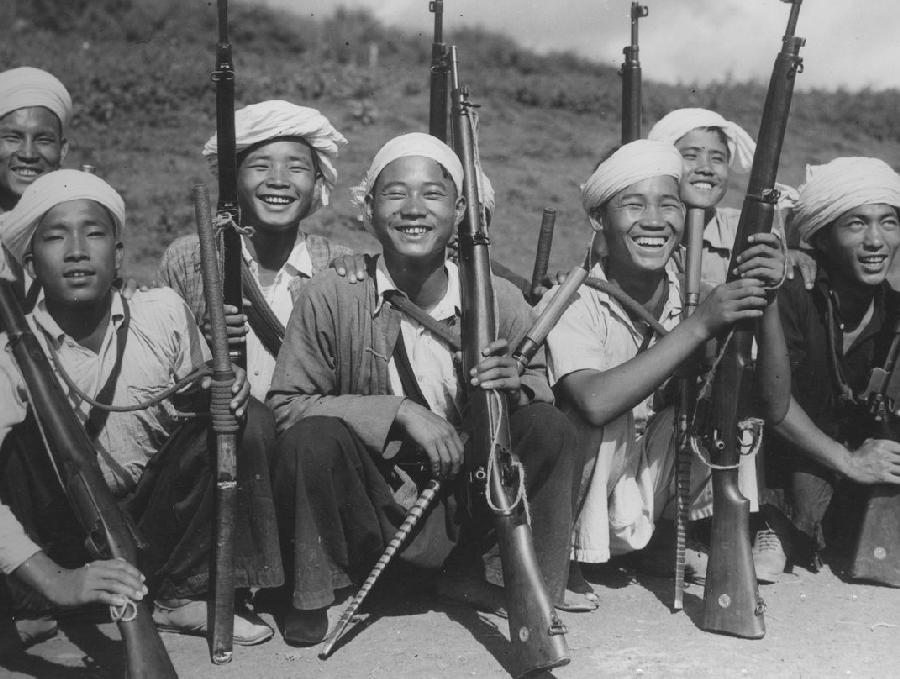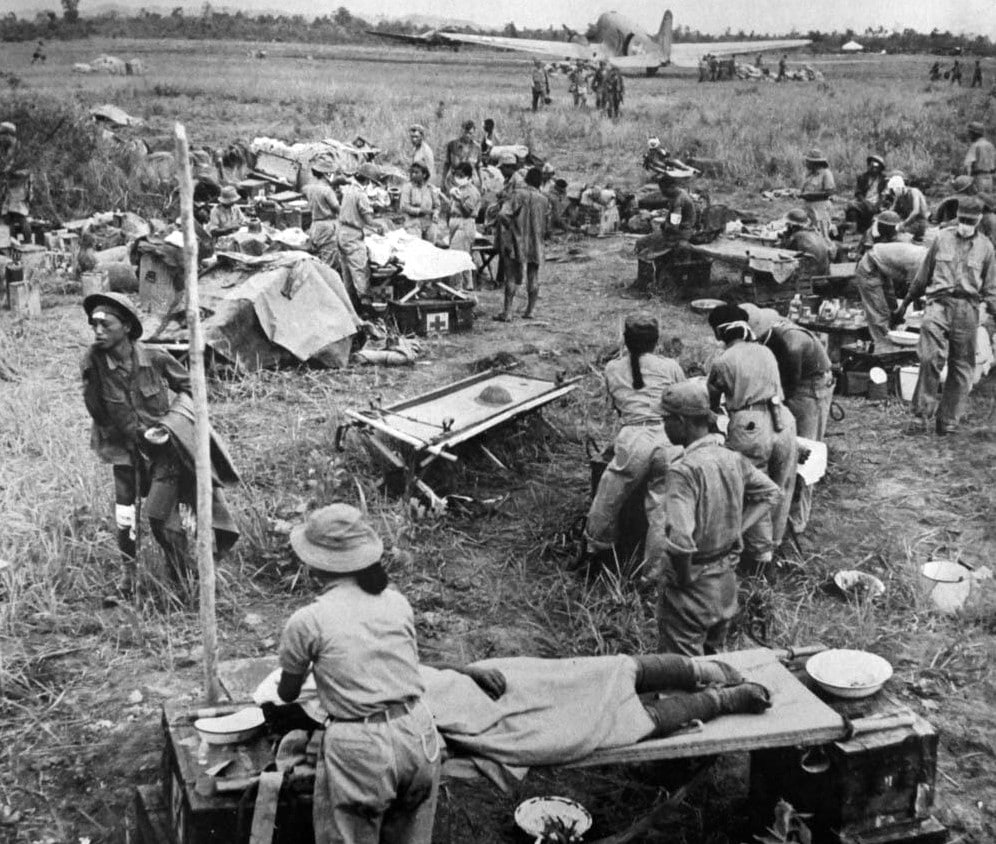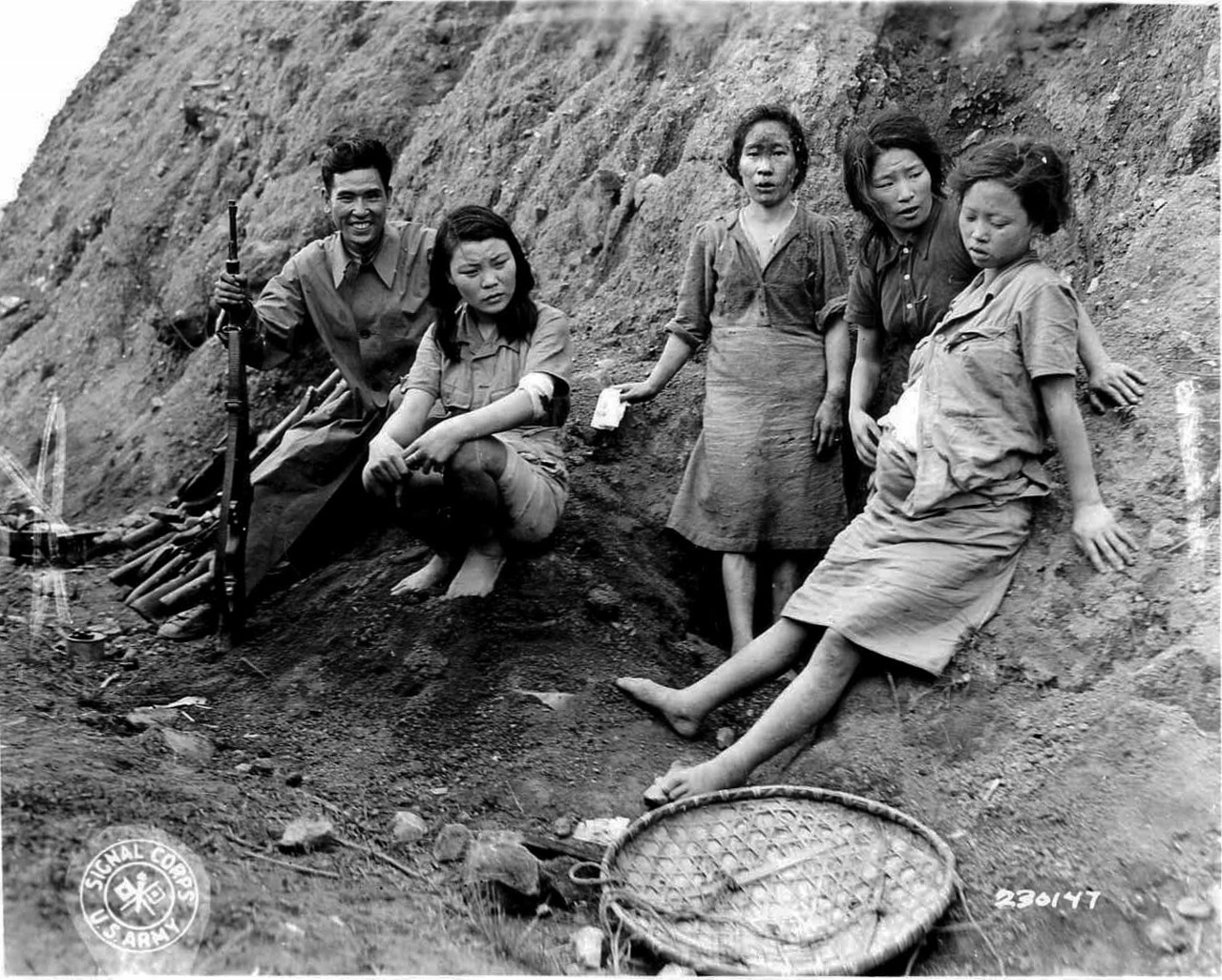THE MOVE TO MYITKYINA
Moving out on Apr 28, they established several roadblocks behind the enemy lines to screen the main effort and directed a strong column toward Myitkyina. The column crossed the Kumon Range which rose in this area to over 6000 feet (1850-M). The trail selected for use has been reported as impassable and had not been used in ten years. Capt William A. Laffin and Lt Paul A. Dunlap with a group of 30 Kachin Levies and 30 coolies were assigned the mission of preceding the main column and repairing the worst places along the route. In spite of the extreme difficulty caused by the monsoon rains and low clouds, airdrops were carried out successfully. Rain fell daily and the damp heat was stifling. Footholds had to be cut in some places where the train was so stepped that pack animals could not negotiate it otherwise. In places, no path of any sort could be found despite the work of Capt Laffin’s advanced group. Twenty packs of animals with their loads of ammunition and weapons slipped on the uncertain footing of the hillsides and plunged to their death in the valleys far below.
OSS 101 (Office of the Strategic Services Detachment 101) furnished the force a Kachin guide who led them on a circuitous route through the jungle and the paddy fields in order to reach Myitkyina unobserved by either the Japanese or the natives. The guide, Nauiyand Nau, was bitten by a poisonous snake in 2030 on May 15, just as the force reached the upper Namkwi River about 15 miles from the objective. He attempted to go on but within a short time, he was unable to walk on his badly swollen foot. Without his guidance, the Marauders were practically immobilized. Capt Laffin and Lt Dunlap decided to make an incision at the spot where the snake’s fangs had penetrated Nau’s foot and for two hours sucked the poison from the wound. By 0230, the Kachin had recovered sufficiently to mount Col Hunter’s horse and continue leading the column toward its objective for the night.
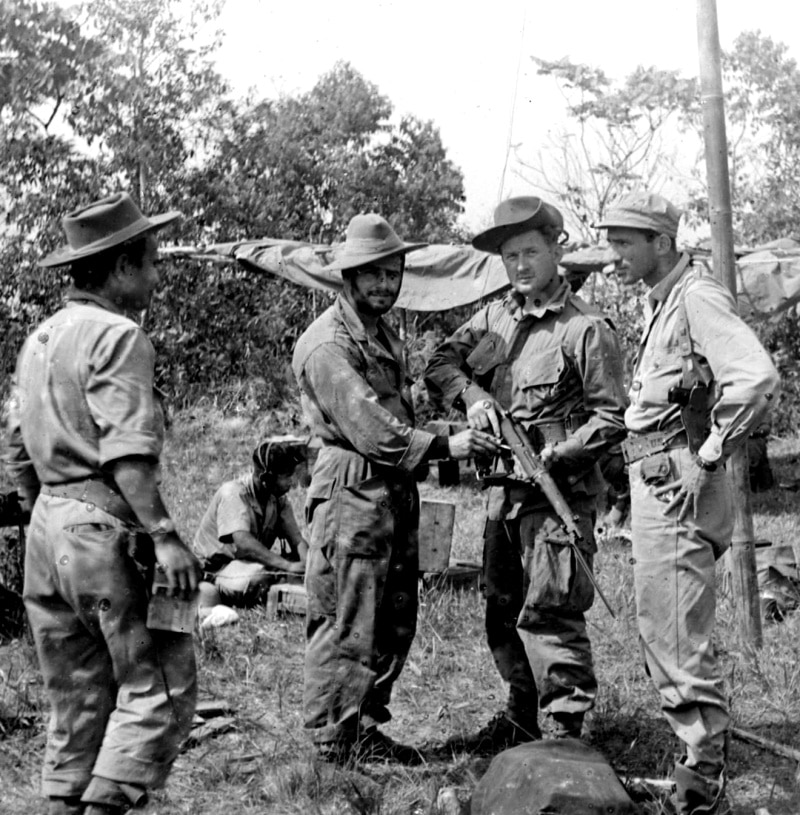 H-Force resumed its march at noon on May 16 and crossed the Namkwi River, near the village of Namkwi. K-Force was feinting toward the enemy supply base at Nsopzup, some twenty miles to the north, while M-Force was blocking roads, trails, and screening the maneuver some thirty miles to the northwest. The only two natives who had observed the column had been taken along with the force to prevent their alerting the Japanese garrison in Myitkyina. In view of the fact that this force was now only some four miles from the airstrip in Myitkyina, Col Hunter took more precautions to keep the movement of his force unknown.
H-Force resumed its march at noon on May 16 and crossed the Namkwi River, near the village of Namkwi. K-Force was feinting toward the enemy supply base at Nsopzup, some twenty miles to the north, while M-Force was blocking roads, trails, and screening the maneuver some thirty miles to the northwest. The only two natives who had observed the column had been taken along with the force to prevent their alerting the Japanese garrison in Myitkyina. In view of the fact that this force was now only some four miles from the airstrip in Myitkyina, Col Hunter took more precautions to keep the movement of his force unknown.
The Kachin guerrillas assisted his men in rounding up all the inhabitants of Namkwi, some of whom were known to be pro-Japanese, and confined them within H-Force’s lines until morning. In order to maintain the secrecy of the Marauders’ arrival so close to the airfield, neither railroad nor telegraph line was cut.
ATTACK PLAN – MYITKYINA AIRSTRIP
Col Hunter selected the time of the attack on the airstrip as 1000, May 17. His plan called for the 1/5307 (Col Osborne), to lead the Chinese 150th Regiment southwest of the field and leave them to attack the airstrip at that point. Osborne and his men were to move southwest and secure the ferry terminal at Pamati. By controlling this terminal, the Marauders had possession of the nearest crossing of the Irrawaddy River. The plan for the attack on the airstrip was based on information brought back by a six-man patrol under Sgt Clarence E. Branscomb which enable Col Hunter to accurately estimate the number of Japanese troops and Burmese workmen on the airstrip as well as the fact that the Japanese habitually withdrew during daylight to the thick scrub and bamboo clumps at some distance from the airstrip in order to avoid strafing of the field by Allied aircraft.
ATTACK ON MYITKYINA AISTRIP
The attack went off as scheduled. The Chinese 150-IR was led to the southwest end of the field and launched their attack from that point. The airstrip was not strongly defended and the attack came as a complete surprise to the Japanese. Sporadic fighting occurred in the morning but by 1200, the airstrip was in Allied hands. Osborne pushed to Pamati and by 1100, he had secured the village and ferry terminal. One company of Marauders reinforced with machine guns was instructed to hold the ferry site, while the remainder of the Battalion returned to the airstrip, where Col Hunter ordered the Battalion to seize Zigyun, the main ferry terminal from Myitkyina. The Battalion left the airstrip at 1700 and moved southeast to the Irrawaddy River near Rampur, bivouacking there for the night, prepared to move on Zigyun in the morning. Immediately after the seizure of the airstrip, Col Hunter radioed Gen Merrill asking for reinforcements and supplies. The airstrip could handle transport planes delivering larger cargoes than could be profitably airdropped. Supplies that had been too bulky or too heavy for parachute drops could now be brought in and light motor transportation could also be made available. The evacuation of casualties could also be carried out much easier now that larger aircraft could be used.
Previously the light liaison aircraft had been required for landings or sandbars, rice paddies, or cleared jungle areas, but now larger aircraft could be used on the airstrip. The Chinese 89-IR waiting on rears fields was ordered to Myitkyina and one battalion arrived at Ledo late this afternoon. Col Hunter also radioed M and K-Forces, requesting their assistance and both forces immediately began a forced march for Myitkyina. When it became apparent that the Japanese were not attempting to reinforce their troops near the airstrip on May 17, Col Hunter concluded that the enemy did not hold Myitkyina in strength. Intelligence reports confirmed his assumption, and although the Marauders were not organized nor equipped for an assault of prepared Japanese positions, he decided to take maximum advantage of his surprise assault by attempting to seize the city. The question confronting Col Hunter was whether he or the enemy could build up strength quicker.
ATTACK PLAN MYITKYINA CITY
Gen Frank D. Merrill (CO Galahad) flew in and established his Hqs ordering Col Hunter to attack Myitkyina with the disengaged portion of the H-Force. Two battalions of the Chinese 150-IR were to attack Myitkyina, while the one battalion of the Chinese 89-IR, which was flown from Ledo and had just arrived, would protect the airstrip. The third battalion of the Chinese 150-IR was to remain in reserve at the airstrip. The 1/5307 would continue to hold the ferry terminal on the Irrawaddy River at Pamati with one company reinforced and the remainder of the battalion would continue toward Zigyun to secure the other ferry crossing south of Myitkyina. If done this way, the H-Force would then control two of the approaches to Myitkyina from the south.
ATTACK MYITKYINA CITY
On May 18, the 1/5307 (-) seized Rampur where they captured several warehouses of clothing and other supplies. They occupied Zigyun without opposition by 1000 and took several Burmese prisoners. While defensive positions were being prepared, the battalion was informed that a company of Chinese was on there to relieve them and that they were to return to the airfield. This relief was considerably delayed as the Chinese unit engaged several groups of enemy stragglers en route and consumed 48 hours in reaching Zigyun. The Chinese had to dig in nine times in five miles. On May 18, the two battalions of the Chinese 150-IR attacked Myitkyina from the north. After seizing the railroad station, they became involved in confused fighting and had to retire to a position about 800 yards west of the town, where they dug in. The primary reason for the failure of the attack and the confused fighting of the Chinese was the discovery of a supply of native liquor and the looting of a jewelry store. K-Force was approaching Myitkyina, however, the guides lost their way about eight miles from the city and the unit was forced to bivouac for the night.
With daylight, K-Force discovered the Myitkyina – Mogaung Road near their perimeter, and they pushed on along this road. Learning of their approach, Gen Merrill radioed K-Force to attack and secure Charpate, which they did without appreciable Japanese resistance, and the 3/5307 dug in around the village, while the Chinese 88-IR moved to the southwest on a line from Charpate to the railroad. The mission of the 3/5307 was to block the Mogaung Road and to patrol the trails converging on Charpate. The village of Charpate was situated in a flat area surrounded by rice paddies. The ground rises slightly four to five hundred yards to the northwest and this high ground was covered with a dense growth of scrub and vines. The 3/5307 overlooked the importance of this high ground in preparing its defensive positions.
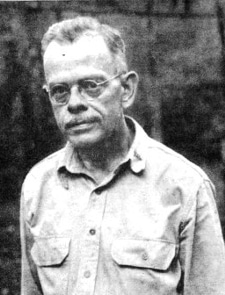 Still, on May 18, Col Gordon S. Seagrave, the famous Burma Surgeon, landed on the airstrip at Myitkyina with four medical officers and eighteen Burmese nurses. He immediately established his small hospital in a revetment adjacent to the airstrip and began operating on Chinese casualties.
Still, on May 18, Col Gordon S. Seagrave, the famous Burma Surgeon, landed on the airstrip at Myitkyina with four medical officers and eighteen Burmese nurses. He immediately established his small hospital in a revetment adjacent to the airstrip and began operating on Chinese casualties.
One day later, on May 19, small bands of Japanese trying to enter Myitkyina via the Mogaung attempted to the perimeter hold by the 3/5307, however, none of these engagements was serious. Gen Merrill began a buildup of his force along the Namkwi River to the southwest of Charpate. The reinforced Company of the 1/5307 at the Parmati ferry was relieved by a company of the Chinese 150-IR on May 19, and the Marauders company returned to Namkwi to take up a defensive position along the Namkwi River. The M-Force reached Namkwi the evening of the 19, ill and weak from hunger, for the supplies of food which they had requested and anticipated had not been dropped. Food was secured from H-Force, and the unit then out-posted Namkwi and patrolled to the west and the southwest. Merrill had now placed his lines so that the Japanese reinforcements could reach Myitkyina only across the Irrawaddy River to the east or along the Irrawaddy Mankrin or Myitkyina Radhapur Roads from the north. The Allies covered all approaches from the northwest, west, southwest, and south. Thus far, the enemy activity had been slight; even the airstrip was handling an ever-increasing amount of supplies, in spite of continual sniping.
CIC ACTIVITIES MYITKYINA
The first Counter Intelligence Corps personnel arrived in Myitkyina at this time and began preparations for carrying out counterintelligence missions of the command. British Intelligence Agencies had classified the residents of the area into three categories of security risks. (1) The Black List: containing names whose presence in the area was prejudicial to Allied security and whose apprehension and incarceration was desired by the British. (2) The White List: containing names of persons who were known to be loyal to the Allied cause and could be trusted to cooperate. (3) The Gray List: containing names of persons who could not be placed with certainty in either of the above categories. These lists had been prepared as a result of interrogation of civilian and military personnel fleeing Burma in 1942, as well as information gained by Gen Orde Wingate’s LRPGs which had operated in south-central Burma. With these lists in their possession, the Counter Intelligence Corps Agents undertook the task of screening the large refugee camp which was being established at Pamati. (Personal knowledge; Statement of Maj D. E. Mackenzie, then Commanding Officer, Counter Intelligence Corps, China – Burma – India Theater, May 29, 1944.) 
The Japanese were sending the residents of the town out of the Marauder lines in an attempt not only to cause confusion but also to conserve for themselves what little food there was in Myitkyina. The refugees were fed by the Allies in spite of the additional strain on the air supply facilities. In addition, a few Burmese had made huge profits trafficking in American flyers shot down over Burma. After having received a large prepaid reward of silver Rupees which the American flyers carried for the purpose of rewarding anyone who helped them return to Allied lines, the Burman would bury the silver Rupees where he could reclaim them at a later date, and then lead the American flyer into the hands of the Japanese. In this manner the Burman received two bounties; one from the American flyer, and another from the Japanese who were paying large sums for American flyers.
Several of these individuals were captured as a result of the interrogation of the refugees and investigations conducted in the hills surrounding Myitkyina. Native labor for use on the airstrip was screened and refugees and line crossers were interrogated for information of tactical value. Information was gathered on Japanese strength, morale, supplies, and the location of headquarters and command posts in Myitkyina. Maj White of the British Civil Affairs Services arrived in the area and took charge of the stockade which was housing a large number of Burmese. One young girl was engaged in the dangerous occupation of running Japanese troops through the Marauders’ lines.
After her capture by the Counter Intelligence Corps, she readily admitted that she had led numerous groups of Japanese soldiers through the Kunai grass and jungle surrounding Myitkyina into the city, using several devious routes whereby she had been able to avoid Marauder or Chinese lines, patrols, or outposts. This young girl was later executed by the British for her assistance to the Japanese in the Myitkyina campaign. It was learned from refugees at the Pamati camp that a number of Japanese comfort girls had been present in Myitkyina when the city was attacked. The comfort girls were camp followers of various Asiatic races whose mission was to entertain the Japanese troops, a sort of legalized prostitution. Efforts were immediately made to locate these women, and one by one they were gradually accounted for; one was not found until many months later when she was located living in India. The pilots of transport planes leaving Myitkyina airstrip for India had been only too glad to furnish transportation to their bases in India for any refugee who had asked, and as a result, a close check had to be maintained at the airstrip to ensure that no civilians left Myitkyina without authorization. In spite of this security check at the airstrip and the briefing of all flying crews’ landings at Myitkyina, illegal air traffic flourished.











